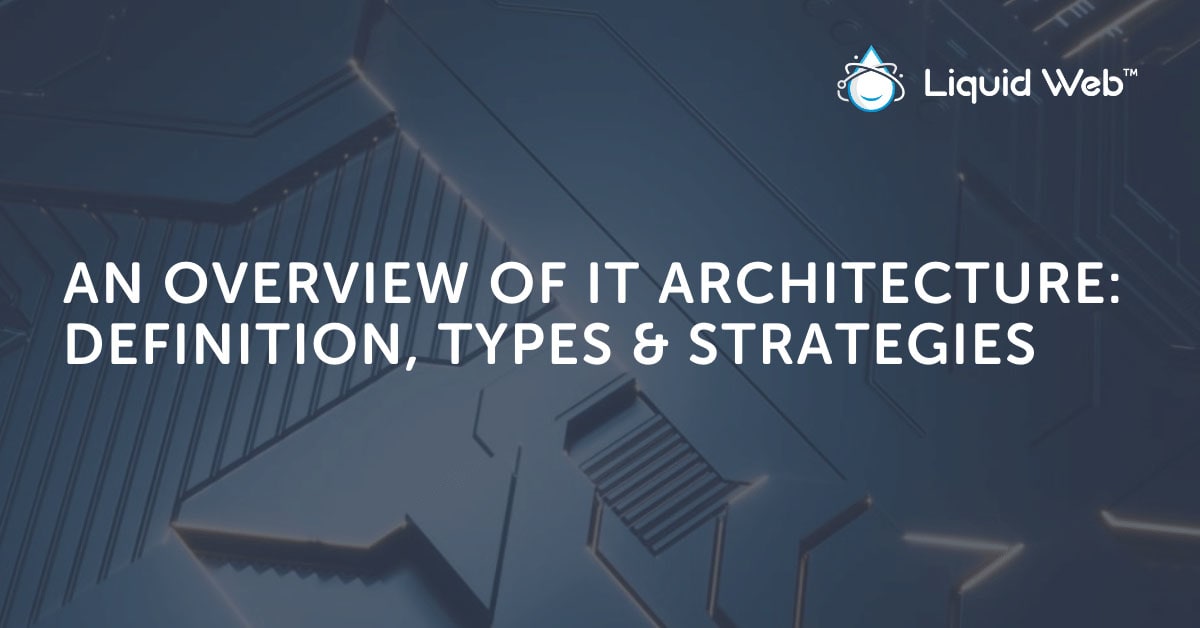
IT architecture strategy is an underlying yet essential part of every business. As the organization grows, the online aspect of business becomes more complex, which is why it needs to cover more and more factors, including the architecture.
What is IT Architecture?
For those wondering, “what is IT architecture?” it is the overall design of a computing system and interrelationships between its components. It’s an area specifically focused on software, hardware, and protocols, and access methods used in the entire system.
An IT architect is the guiding person, committee, or team in charge of all of your computer systems. They are in charge of designing every single part of the business’ network so that you can stay focused on the core of your business.
History of IT Architecture
IT strategies have been changing through different periods and business models, each coming with different components. Here is a complete history of IT architecture strategies over the past 70 years:
Structure And Design (1950s)
Strategic moves in a structure and design approach were based on an interdependent analysis of the company’s external environment, together with the internal practices and resources. The strategy was successful if there was a two-way fit between the opportunities and threats from the outside and the resources from the inside of the company.
We can find such strategic planning in enterprise resource planning (ERP) systems. Another case is global single instance architecture (GSIA), where global apps serve a function for a company on a worldwide scale.
Diversification And Partitioning (1960s & 1970s)
During the 1960s and 1970s, organizations were diversified away from the core of their business. This resulted in a situation where strategic business units became semi-autonomous regarding profit and strategic planning rather than having a corporate system.
Strategies increasingly started focusing on the capabilities and the resources of the individual units. That way, enterprise architecture became a matter of building and maintaining manufacturing technology. They worked on a strategic fit to those areas of business their units completed.
In high-growth situations, EA was decentralized and more focused on the business units. On the other hand, low-growth situations called for reduced costs and scaled benefits, negatively impacting efficiency.
An example would be online collaboration centers for upstream gas and oil. These were problem-solving centers that covered various areas, and they brought together drilling engineers, geophysicists, petrochemical engineers, and geologists to participate in a cross-disciplinary process.
Competitive Positioning (1980s and 1990s)
In this approach, the strategy was all about comparing different markets and their attractiveness. The next step was to choose a proper strategy in each of the selected markets and build a defendable position there.
Two vital characteristics were:
- The ability to share resources across the units and the value chain.
- An analytical framework that helped the enterprise architect to concentrate on core activities.
They want to link these activities and make them stronger through automation. That way, the architects could enable the data flow between process steps without the intervention of employees.
We can offer two examples here. The first one was business process re-engineering (BPR). That was an attempt to optimize the company’s value chain and get to the defensible position through differentiation in how certain activities were performed.
The second one was the creation of common platforms for sharing information. This helped business units to cooperate in various activities such as research and development as well as joining value chains.

3 Types of IT Architecture
To better understand IT architecture, we can compare it to structural architecture or building plans. It consists of different levels, such as the general architecture of the entire building, plans for each floor, and, in the end, interior designs.
You can apply the same principle in IT architecture, which is why we differentiate between three types of IT architecture: enterprise architecture, solution architecture, and technology architecture.
Enterprise Architecture (EA)
Enterprise architecture (EA) defines the overall architecture of the company. This includes all the company’s IT systems and apps across different departments, such as:
- Core and satellite applications.
- Portal, web, and mobile apps.
- Integration platforms.
- Data analysis tools.
- Operational and development tools.
The EA is the blueprint of the entire company, and it gives you a logical map of the overall IT system. The goal of EA is to make IT work well for the whole business and align with corporate goals. With this in mind, an EA expert needs to understand both business and IT at a high level.
Solution Architecture (SA)
Solution architecture is focused on the functionalities a specific system performs. It is a detailed description of the processes needed to meet the business objectives as well as all the relevant information associated with them.
In other words, solution architecture is about IT system specifications, translating requirements into a solution, and usually applies to a single project or release. It is the functional architecture of a system or an application.
Technology Architecture
Technology architecture describes the details of the different technology components needed to meet a company’s goals, including the logic that governs them and the rest of the relevant data.
Experts in technology architecture focus on designing components to find cost-effective hardware and software solutions for your company. In other words, technology architects are like the gateway between the software development team and the business needs.
EA Model For Developing The Best IT Architecture Strategy
Enterprise architecture is all about the distribution of IT resources into a business strategy. It creates a logical bond between the strategic goals, the created data, existing business processes, and the infrastructure that supports the entire business.
Business Architecture
The first step of a good EA strategy is to understand your company’s business outcomes. After that, you’ll be able to align them to the organization’s overall mission, as well as tie your goals to the operational tactics.
Once it’s clear what your company wants, it’s important to partner with functional leaders. That includes focusing on goals, the business’s needs, and choosing the right technologies to support and enable your objectives.
Data Architecture
Data architecture focuses on the way functional leaders use data. In other words, you want to create a bridge between data and business strategy and understand how data will flow within the entire organization.
Application Architecture
In this stage, technology leaders get to choose the right apps and tools that will best help your company achieve its goals. Some of these tools can be internal.
For example, let’s say you have an app that handles personal employee information and is connected to onboarding and recruitment tools. This type of data can be connected to a learning management system so that you can track their training paths and growth. If you connect such apps, it can help the HR team to collect and manage valuable insights about employees.
Also, apps can be external, which means they’re directly related to digital channels or even customer-facing products. For instance, let’s take a company that does financial services. They sell an app that helps banks process their customer transactions. If the company offers multiple related products, like web or mobile banking, these different products need to work flawlessly.
Finally, the end user should see it as a single system. A single-app architecture positively affects the entire user experience, operations teams, and product development.
Technology and Infrastructure Architecture
It’s vital to see if the company really has all of the technology needed to support different apps and business tools. That means having good software and hardware as well as meeting the requirements of tools the organization needs (e.g., cloud storage, on-premise servers, security, etc.).
When it comes to technology architecture, it is important to find out if the infrastructure will support your company’s growth. It’s also critical to understand the information architecture for your site.
Growth itself is rather challenging for every company, especially keeping a business running during a pandemic.
3 Best IT Architecture Strategies
Here are the three best IT architecture strategies for the digital age:
1. Reconsider Enterprise Architecture Principles
As an essential part of IT architecture strategy, digital EA revises standards, policies, and principles. Its role is also to recognize and adapt the best digital practices that will keep the focus on customer centricity. In competitive environments of the digital age, companies can only survive if they pay as much attention to their existing customers as they do to acquire new ones.
2. Emphasize Experience
The key to digital success and IT architecture strategy, in general, is creating special and unique experiences for your customers. To achieve that, companies today use tools such as journey maps or customer personas. In fact, in a digital world, tools such as personas have become the standard.
EA also helps offer a holistic enterprise portfolio that emphasizes solutions and projects covering all customer satisfaction and experience segments. This can also be used to derive some other enterprise models when possible.
3. Develop a Design-Driven Architecture
Take your IT architecture strategy to the next level and cultivate innovative design-driven culture. It’s not enough to focus on operational excellence only – the competitive business world asks you to have a unique, intriguing design that will attract visitors.
Design Value Index is an excellent tool you can use to quantify your design. It’s a powerful indicator that distinguishes various design factors and tells you why they make your design different.
Modern Cloud IT Architecture With Liquid Web
Liquid Web helps companies of all sizes create a modern cloud architecture, set the entire structure of your online business, and adjust it to the specific needs of your organization.
The more aspects of your website you have in control, the more you can do to take your business to the next level.
Private Cloud is your own virtual data center. Powered by NetApp and VMware, it offers high availability, flexibility, compatibility with legacy systems and software, and extreme performance. Contact us today to power your modern enterprise today on the cloud.
[ad_2]
Source link







